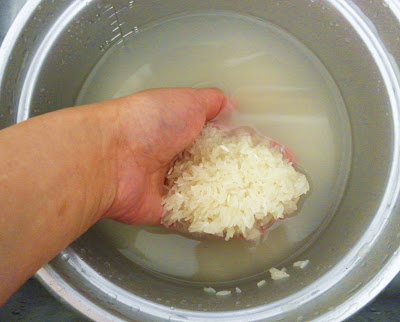Rice is Asia's staple of food and crucially important to the Asian way of life, culture, customs, traditions and spirituality. Almost 7 billion Asians live on rice. Many think of rice as being a Chinese food but in the modern days now it is eaten all over the world. Rice is arguably the world's most important food as it is second most widely cultivated cereal after wheat. In much of Asia, it is so central to the culture that the word is almost synonymous with food. For Chinese the line in the Lord's prayer is translated as "give us this day our daily rice" and a Japanese proverb stated that "A meal without rice is no meal".
There are over 7 thousand varieties of rice grown around the world but there are only a few varieties that most consume and consider nutritious. Rice is roughly divided into 2 simple types. The "Japonica" and "Indica". Japonica rice is usually grown in temperate climates. The grains are round and do not easily break off or even crack. When cooked, this rice is sticky and moist. Rice produced in Japan is mostly Japonica. Indica rice is usually grown in hot climates. It is long and tend to break easily. The grain is fluffy and does not stick together. Most rice produced in Southern Asia including India, Thailand, Vietnam, Malaysia and Southern China is Indica rice.Both Japonica and Indica types of rice include non-glutinous and glutinous rice. Each type of rice has its own characteristics and each has its own way in cooking. Non-glutinous rice is used in general cooking. It is nearly white and transparent. It is full of impurities which are actually nutritious for us. Glutinous rice tends to be more whiter and sticky when cooked. Commonly used to make rice cakes or various kinds of desserts.
With over more then half the population of the world eating rice two or three times a day, it is not surprising that there are many arguments over how it should be cooked. Indeed rice can be cooked in a variety of ways - boiling, baking, roasting, frying and pressure-cooking. Rice is best cooked immediately before serving, but cooked rice can be kept in fridge for up to 4 days but after 3 days it will be dry out. Leftover rice is good for stir-fry, which producing different fried rice. Its easy in preparation, very flexible and it got the ability to absorb flavours in retaining its texture. Rice dishes can be spicy or tangy, savoury or sweet. Rice soaks up gravies and rice sauces and cools and refreshes the palate when served with spicy food. Baked with milk and sugar, rice transforms itself into one of the western world’s best-loved creamy puddings. Rice has no fat, no salt and no sugar but many important nutrients.
My British friends cooked rice by boiling them in water and then strain all the water off before eating. In India, rice is cooked with sufficient water in electric cookers or pots under wood fire until fully cooked and is served either piping hot or warm on a banana leaf that magnifies the aroma. It is also cooked in a special procedure of sautéing with ghee, spices and vegetables with sufficient water and yoghurt. This recipe is called Briyani rice with different variations of meat and seafood cooked together with the rice. This is an equivalent of Paella from Spain and Jambalaya from South Africa. In Japan, rice is steam-cooked with vinegar to make sushi. In Malaysia, rice is cooked in a lot of water which is called porridge. The best porridge is prepared by the "TeowChew" Chinese which originated from China and one of many peasant food made into gourmet food or fast food. Even McDonald in Malaysia sells chicken porridge which is now widely accepted and enjoyed by other races. For the Malays, rice can be thickened with coconut or flavoured with aromatics like star anise or fried rice. Rice is being creatively prepared all over the world and being accepted in nearly every country as either a source of carbohydrate, snack or dessert. Little wonder then that many of the world’s finest dishes have been based around it. It is hard to imagine living in a world without rice.
There are no exactly rules on how to cook the rice. My mum cooked her pot of rice just like how everyone did back in the olden days. We use electric rice cooker back in Malaysia. Fast, convenient and this is how we do. Funny thing is, my British friends were quite surprised that there is a thing called rice cooker. Like I said, there is no definition on how to cook rice.
This is how my mum taught us to cook rice:-
 |
| I have this hardcore rice cooker for more then 7 years.. all the way from Malaysia to UK |
- Washed rice by rinse it at least 3 times until the water runs pure. Drain. Back then, my mum would kept the water ( washed from the rice) to use it for her face mask. She claimed that its better then any moisturiser cream !
- Now many people said 1 cup of rice with 1 1/2 cup of water that theory. In the olden days, grandmothers and mothers cooked with their own way. There is no need to have measurement on things with Chinese cuisine to be frank. This is the trick my mum taught, and still using up until now with in my family.
- Place the washed rice in the pot. The most easiest way to measure the water is to use the knuckle trick. The water should come up to the first joint of the knuckle. No matter how many rice to cook, this is still going to work fine.




No comments:
Post a Comment